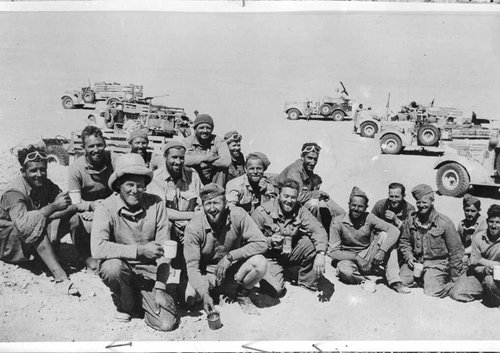
By sound history researcher Sarah Johnston
Hero image: Men and vehicles of the Long Range Desert Group on patrol, 1941. [Alexander Turnbull Library. Ref. DA-01085-F].
During World War II, a British military unit was formed for raiding and reconnaissance missions behind enemy lines in the desert regions of North Africa. It was made up of men who were independent, self-reliant, and both physically and mentally tough. They had to be able to survive in the desert, without support, enduring extreme conditions with few resources. Viewers of the recent BBC television drama series Rogue Heroes might be thinking of the Special Air Service or SAS. The series charts the regiment’s formation in North Africa and dramatises several of their actual raids on German and Italian installations and airfields, all set to an AC/DC rock soundtrack. Despite it taking some liberties with facts, British historian Antony Beevor praised the series in The Guardian, calling it ’rock star history’. But the subject of this blog is a military unit that pre-dates the 'Rogue Heroes’ by 18 months. It was the Long Range Desert Group (LRDG), formed in June 1940, largely of New Zealand men. They came to work closely with the ‘rogues’ on occasion and have been called ‘the brains behind the SAS brawn.’(1)
The LRDG appear in the television series, in the real-life character of navigator Mike Sadler, who helps the SAS find their way over the vast, unmapped Libyan desert, as his unit did in real life. Sadler was from Southern Rhodesia (now Zimbabwe) and while the LRDG drew members from various Empire forces, initially the majority of its men were New Zealanders. As such, they were a natural target for the New Zealand Broadcasting Unit’s radio microphones, and the surviving sound archive held by Ngā Taonga Sound & Vision contains a collection of fascinating wartime recordings of the voices of these hardy and resourceful men. The links to listen to all the recordings mentioned here can be found at the end of this blog.
We are also fortunate in New Zealand to have a collection of photographs of the group on desert patrol. Personal cameras were forbidden in the New Zealand Division as a security risk, but some of the LRDG men still carried unauthorised cameras with them, and amazingly, one even had a film camera. The majority of images seen here are from the collection held by the Alexander Turnbull Library, many taken by the men themselves.
The LRDG was the brainchild of Royal Signals officer Major Ralph Bagnold, a Briton who had spent a decade between 1925 and 1935 exploring the geology of the Libyan Desert, including the vast interior region known as the Great Sand Sea. He pioneered many techniques for navigating the impassable wastes, such as a ‘sun compass’ that was unaffected by iron ore deposits in the soil or metal motor vehicles, and learned to reduce tyre pressure to help drivers negotiate loose sand dunes.
When war broke out these became useful skills for gathering tactical intelligence in the North African theatre of war, and Bagnold suggested to British military chiefs that he establish a mobile scouting force for desert operations. Bagnold felt New Zealand farmers would have the necessary mental and physical resilience to cope with the remote, desert conditions, as well as familiarity with repairing motor vehicles and driving in rough terrain. He approached the First Echelon of the New Zealand Division for volunteers and was overwhelmed with the response – it has been said half the Division in Egypt at the time offered to join him (2). Later, men from British, Indian and Rhodesian regiments also joined the LRDG, but it remained a small unit, never numbering more than 350 men.
The LRDG captured public imagination in New Zealand once news of its exploits began to reach home. After raiding and patrolling through Libya in the second half of 1940, its existence and successes were publicised by the military with a report by official war correspondent Robin Miller published throughout New Zealand in February 1941. Somewhat breathless headlines announced ’N.Z. Troops Rove Sahara. Become Heroic Modern Outlaws in Long Range Desert Group.’ Miller (who also recorded several radio reports with the Broadcasting Unit) likened the LRDG to ‘desert pirates… swooping and darting in swift trucks throughout the length and breadth of Libya like modern outlaws.’(3)


Northern Advocate, 15 February 1941, p3 [via Papers Past].
The swash-buckling image was reinforced when photographs were published of the men swathed against the desert sun and sand in traditional Arab head dress. Many grew beards when out on patrol, which was also unconventional at a time when facial hair was uncommon in the forces, except amongst men of the Royal Navy.
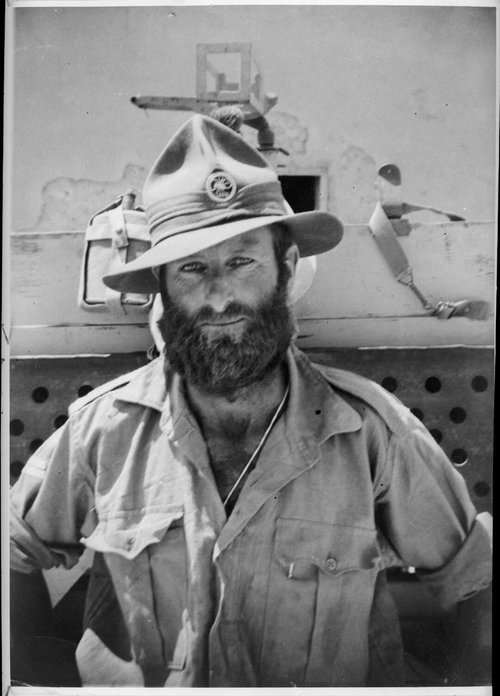
Sergeant Dick Lewis after two or three months in the desert with the LRDG
Photograph taken on 15 July 1942 by Trooper F. Jopling. [Alexander Turnbull Library, Ref. DA-02562-F].

Men of the Long Range Desert Group on parade for General Auchinleck
Cairo, January 1941. [Alexander Turnbull Library. Ref. DA-02076-F].
The New Zealand Broadcasting Unit made its first recordings with the LRDG in February 1941. As this was the same time as the first newspaper articles were published, it was probably part of a coordinated publicity campaign by the newly formed Public Relations Service of the 2 NZEF. (The broadcasters fell under this office, together with press war correspondents, official photographers and the government film unit cinematographers.) In the first recordings, commentator Doug Laurenson introduces the LRDG and describes the harsh terrain in which they operate, including areas ‘as lifeless as the moon, where it rains only once or twice every 25 years.’ Unusually, he then hands the microphone over to one of the men, Lawrence Hamilton ‘Tony’ Browne of Wellington (military service number 4444) who carries out the series of short interviews with his comrades, speaking to a further 10 LRDG men.
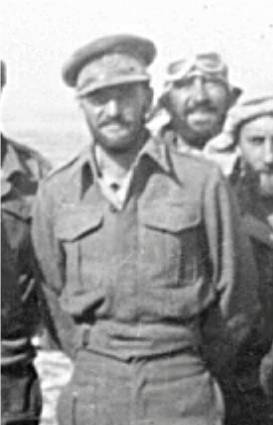
Lawrence Hamilton ‘Tony’ Browne
Image via Online Cenotaph, Auckland War Memorial Museum. No known copyright.
Tommy McNeil of Hawkes Bay (1253) and Cyril Eyre of Te Awamutu (1305) talk about techniques for driving in soft sand and explain that the New Zealand patrols’ vehicles are given Māori names. Roy Kitney (3863) a cook with the unit, talks about rations and how they cook when out on long range patrols, while Eric Smith of Hamilton (1065) recalls receiving rations from the Free French troops and confusion amongst the New Zealanders over how to prepare coffee beans. Second Lieutenant Dick Croucher (8803) is interviewed about navigating in the unmapped desert using sun compasses and star observations at night. Sergeant Ian McInnes of Whangārei (1052) recalls a nine-day patrol in the Libyan desert in which they attacked and destroyed an enemy fort. This was at Murzuk and McInnes was later awarded the Military Medal for his bravery during this action.
Len Hawkins of Christchurch (7377) a fitter and gunner with the LRDG, talks about how vehicles are maintained in the desert, with few supplies or spares available. Next to speak is Peter Garland of Auckland (1366) who tells New Zealand radio listeners about the incredible heat the men endure in the Libyan desert. Edgar ‘Sandy' Sanders (598) of Christchurch outlines his work as a member of the gun crew and finally Frank Jopling (1314) describes meat provided by local tribesmen who killed goats and bullocks for them when they were travelling with the French forces in the Tibesti Mountains. These were the Senussi, a Libyan clan who had long fought against Italian occupation of their lands and allied themselves during World War II with the LRDG and Free French.
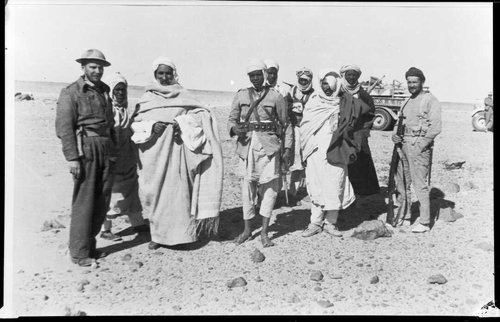
Members of the LRDG in Libya, with members of the Free French and Senussi
January 1941. From left to right: Captain F B Edmundson, “Midnight”, Sheik Abd el Galil Seif el Nasser, Free French troops, and (on far right) Lance Corporal L Roderick. [Alexander Turnbull Library Ref. DA-00869-F].
From late 1940, the LRDG and the Free French forces from Chad, south of Libya, carried out raids against Italian garrisons in the Fezzan region. The Broadcasting Unit recorded a second group of LRDG men, who describe this campaign and the toll it had taken on them. Captain Leonard Ballantyne of Pongaroa, Hawkes Bay (1398) describes the recent loss in action of two men, Corporal Rex Beech (1093) who engaged Italian machine guns at Kufra and saved many lives, and Sergeant Cyril Hewson (1030) who led his troop into action at Murzuk and was killed in action there. He also mentions the decorations recently awarded to Lieutenant James Sutherland (1013) who gained the Military Cross and Trooper Leslie Willcox (1290) of Hawera who was awarded the Military Medal for gallantry.
Next, one of the LRDG’s medical officers is interviewed. Captain Francis Edmundson of Napier (993, seen in the photos here with the Senussi and Free French) describes the health issues the men face in the desert, and Sergeant Jack Shepherd of Hamilton (1328) talks about radio and signals, and how code is used to communicate between patrols.
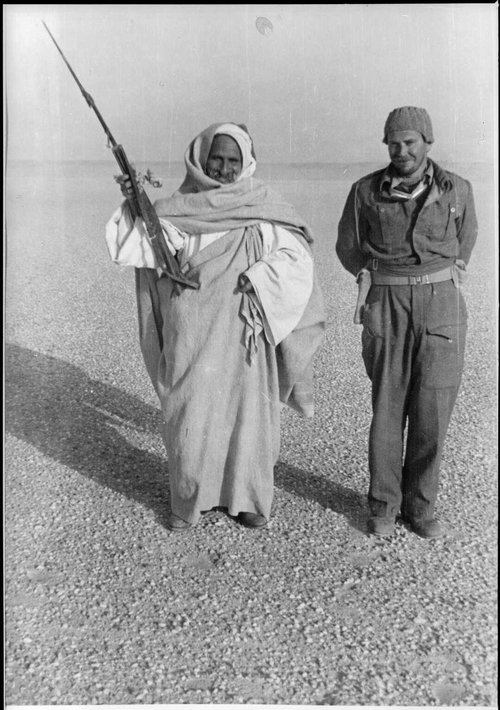
Taken during the Fezzan Raid, January 1941 by Trooper F Jopling
Captain F. Edmundson (right) medical officer with the LRDG and Senussi Chief Sheik Abd el Galil Seif el Nasser. [Alexander Turnbull Library Ref. DA-00871-F].
Something of a scoop for the New Zealand broadcasters came two days later, in the form of an interview with the LRDG founder himself, Major Ralph Bagnold. Due to wartime censorship, his name and rank could not be mentioned at the time, but Bagnold opens the 20-minute recording by noting how pleased he is to speak via radio to the families and friends of the men he commands. He credits their upbringing in New Zealand for the self-reliance which has allowed them to quickly adjust to the difficult life in the open desert. Bagnold then gives a report on their activities over the past few months in the Fezzan, harassing Italian forces, capturing forts, blowing up aircraft and fuel dumps.

Taken during the Fezzan Raid in January 1941 by Trooper F Jopling
Aerodrome at Murzuk set on fire by part of the Long Range Desert Group (LRDG) T patrol under Lt L B Ballantyne. Three planes were burned. [Alexander Turnbull Library Ref. DA-00889-F].
In letters to family and to their employer back in Wellington, the New Zealand broadcasters expressed their delight in making these extensive recordings of the LRDG’s exploits. Young assistant engineer Norman ‘Johnny’ Johnston wrote to his parents on 19 February 1941, 'Last Friday one of the most amazing stories of the war in the Middle East was released, that of the Long Range Desert Group... their adventures have been far more exciting than fiction and no praise could be too great for these men of ours.' (4)
Read part 2 here
The recordings written about here have been digitised by Ngā Taonga Sound & Vision and can be listened to online via the following links. Note the length of the original recordings means they had to be recorded over multiple discs, which is why each is split into many parts. These divisions have been maintained in the archival record, although when the interviews were finally broadcast on air back in New Zealand, they would have been edited back together to form one item.
Recordings:
- U-series. Long Range Desert Group. [Parts 1-8] Tony Browne interviews 10 members of the L.R.D.G.
- U-series. Further talks on the Long Range Desert Group [parts 1-6] Captains Ballantyne, Edmundson and Sgt Shepherd of the LRDG.
- U-series. A talk by the LRDG commander parts 1-6 Major Ralph Bagnold.
- U-series. A soldier’s 200-mile desert walk [Parts 1-3] Trooper Ronald Moore describes his grueling desert trek.
- U-series. Diary of a member of the Long Range Desert Group [Parts 1-12] Trooper Frank Jopling reads from his diary.
- U-series. Further readings from the diary of a member of the LRDG [Parts 1-9] Further readings by Trooper Frank Jopling.
References
- Military historian Gavin Mortimer quoted in ‘The little-known story of a crack Kiwi World War II unit, the Long Range Desert Group’, The Daily Mail, 14 April 2017. Reprinted in The New Zealand Herald.
- Doyle, Peter and Bennett, Matthew R., Fields of Battle: Terrain in Military History. New York: Springer Publications, 2002, p.316
- ‘N.Z. troops rove Sahara’, Northern Advocate, 15 February 1941, p.3
- Johnston, Norman Balfour. Personal correspondence, 19 February 1941.
About the author
Sarah Johnston is a former broadcaster and sound archivist, researching recordings made by the New Zealand mobile broadcasting units during World War II. You can read more about the project on her blog World War Voices.